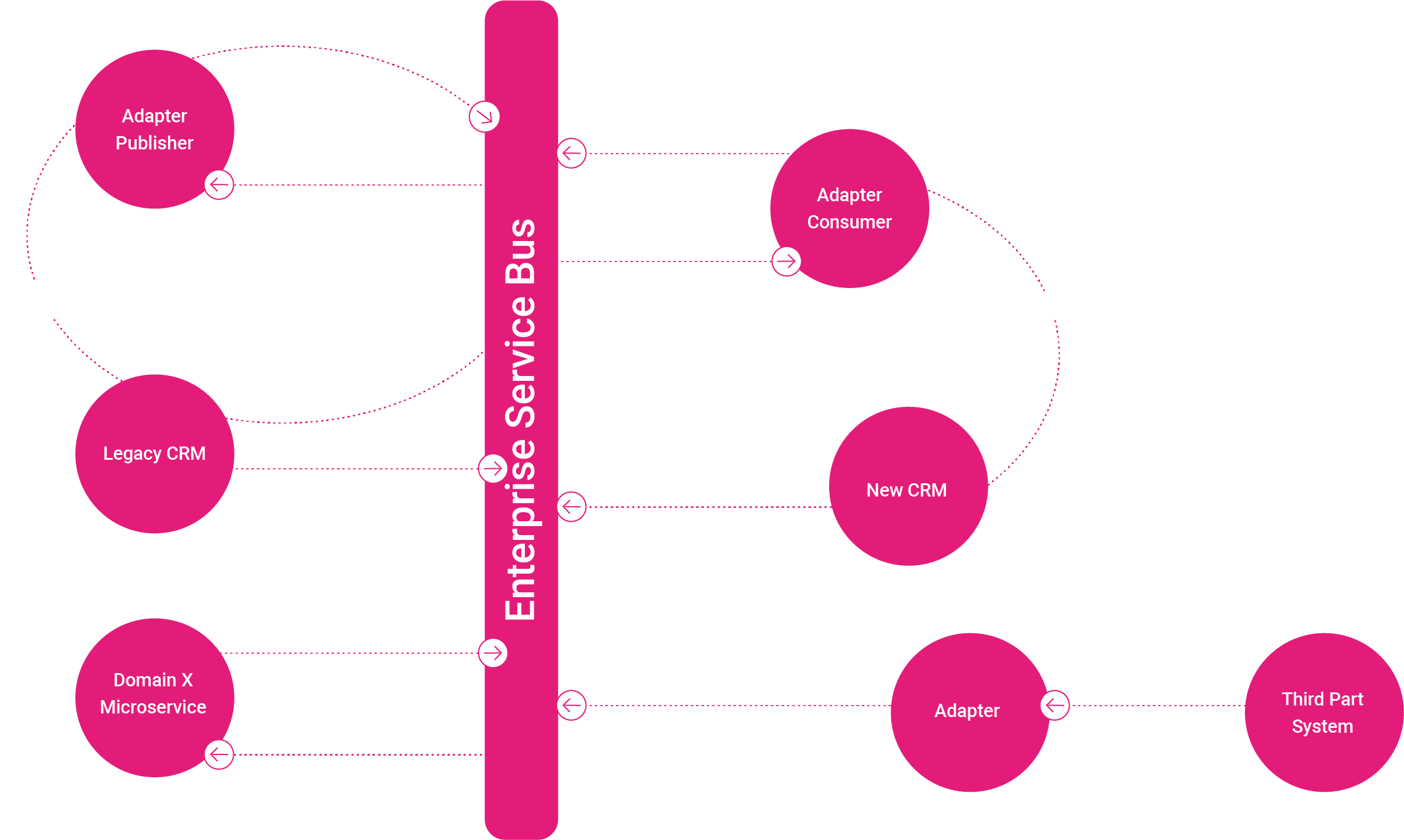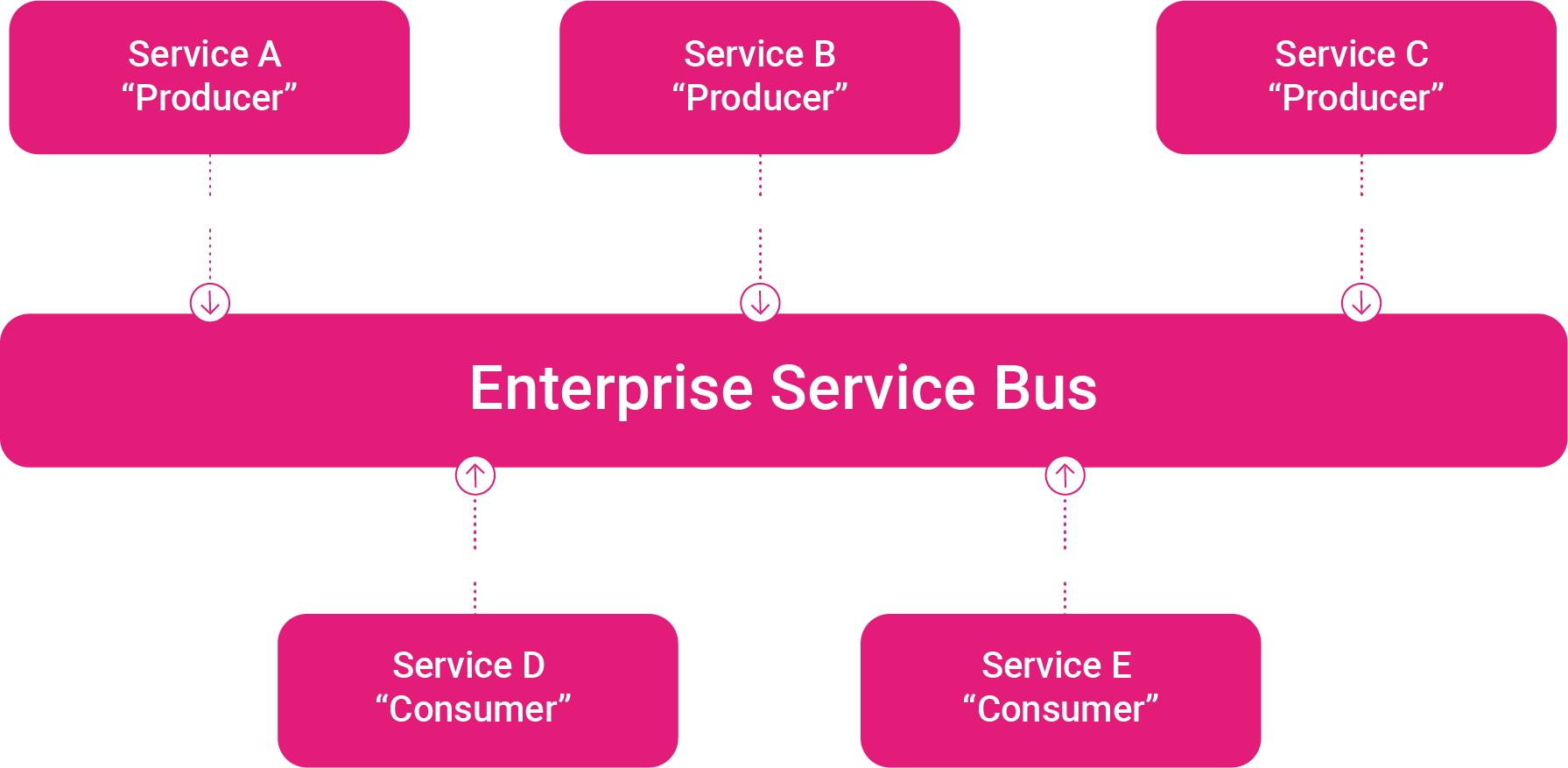
gravity9 System Architecture Guide: ESB
01 Aug 2024 | Cristian Caro
Architecture is a vital aspect of all systems and applications, serving as a blueprint for engineers that defines behavior and structure. There are numerous architectural patterns out there and they can be used on different levels of a system – a single system can use multiple architectural patterns!
As a digital consultancy, gravity9 has a rich history and heritage of development, picking the best architecture for the job.
In this series of articles, we’ll introduce some of the most popular system architecture around. We’ll look at why they’re popular, where they’re useful, and where they’re less useful.
Enterprise Service Bus
Enterprise Service Bus (ESB) is an architectural pattern used in enterprise software development to facilitate communication and integration between various systems and services within an organization. The ESB acts as a central hub that enables different applications to exchange data and functionality, promoting a more flexible and scalable approach to system integration.
Key components and characteristics of an ESB architecture include:
-
Message-Oriented Communication: ESB relies on message-oriented communication. Systems communicate with each other by sending and receiving messages. Messages can be in various formats, such as XML or JSON. These messages are categorized according to your needs. You can define which systems produce messages and which systems consume messages.
-
Centralized Hub: The ESB is a centralized hub (middleware) that facilitates communication between different systems. It acts as a mediator, ensuring that messages are correctly routed and delivered to their intended destinations using “topics” and “subscriptions.”
-
Connectivity: ESB provides connectivity between disparate systems and applications. It abstracts the underlying technical details of each system, allowing them to communicate without needing to understand the specifics of each other’s implementations.
-
Message Routing: The ESB is responsible for message routing, determining how messages should be directed to their endpoints. It can route messages based on content, destination, or other criteria.
-
Transformation: ESB can perform message transformation, converting data from one format to another. This is crucial when systems use different data structures or protocols for communication.
-
Protocol Translation: The ESB can handle protocol translation, allowing systems that use different communication protocols (e.g., HTTP, JMS, SOAP, REST) to interact seamlessly.
-
Service Orchestration: ESB enables service orchestration, allowing multiple services to be combined and coordinated to execute more complex business processes.
-
Monitoring and Management: ESB often includes tools for monitoring and managing the flow of messages. This can involve logging, tracking, and reporting on message exchanges for debugging and performance analysis.
-
Security: ESB provides security features to ensure the confidentiality and integrity of messages. It can enforce authentication, authorization, and encryption to protect data during transit.
-
Scalability: ESB architectures are designed to be scalable, allowing organizations to add or remove systems and services without requiring major changes to the overall integration infrastructure.
Enterprise Service Bus Advantages
ESB is a good choice for organizations that need to integrate multiple applications and systems in real-time (even heterogeneous systems or complex business processes). It provides a comprehensive solution for message routing, transformation, and mediation, which makes it easier to manage multiple integrations and is useful for situations where times data processing, such as in financial services. The use of ESBs is particularly beneficial for organizations adopting a service-oriented architecture (SOA) approach, as it allows for communication between different services.
ESB architecture promotes modular services that can be reused across different applications. For organizations that anticipate growth or changes in scale, ESB can scale to fit those needs without impacting other systems (this also reduces development time and costs and improves consistency across deployed services). This includes legacy systems, as ESB provides a middle layer to integrate older systems with new applications while maintaining business continuity.
An ESB can provide centralized security management, including authentication, authorization, and encryption. It also supports governance by enforcing policies and monitoring service usage, which is vital for compliance and operational excellence. ESBs can provide load balancing and failover mechanisms, improving the reliability and availability of integrated systems. This is crucial in high-demand, mission-critical environments where downtime can have significant business impacts. Last but not least, organizations gain centralized monitoring and management capabilities, making it easier to diagnose issues, analyze performance, and enforce policies across the integrated landscape.
Enterprise Service Bus Disadvantages
Despite its advantages, an ESB might not be the best solution in all scenarios. In smaller or less complex environments, a microservices architecture or simple API management solution might be more appropriate and avoid the overhead of implementing and maintaining an ESB. Similarly, for organizations adopting a microservices architecture, lighter-weight communication mechanisms (e.g., API gateways and direct HTTP calls) might be more appropriate, as they align better with microservices principles (such as autonomy and decentralized governance). The decision to use an ESB should be based on the specific integration needs, the complexity of the enterprise environment, and the organization’s strategic goals. It’s also important to consider the potential impact on agility and the ability to innovate, as overly centralized architectures can sometimes introduce rigidity.
Introducing an ESB can add additional complexity and even introduce performance bottlenecks if not properly implemented. For teams unfamiliar with middleware and integration patterns, a steep learning curve can be introduced, which may provide a barrier to implementation. The complexity of an ESB (a vast array of options and capabilities) can lead to errors or misconfiguration, and demanding, comprehensive security measures must be introduced in order to meet regulatory compliance and data protection standards.
From a business perspective, adopting an ESB can present a high initial cost in purchasing and implementation (especially for enterprise-grade solutions), as well as ongoing maintenance and infrastructure costs to support the system. If your organization becomes dependent on an ESB vendor for support, updates, and extensions, there is a danger of vendor lock-in. Migrating to a new ESB platform can be both costly and daunting, especially with a well-embedded incumbent ESB.
How Does gravity9 Work with Enterprise Service Bus?
gravity9’s client, an enterprise operator in the American rental homes sector, wished for their properties to be published on various partner websites along with a suite of tools allowing customers to search and rent a property. In order to achieve this, a number of complex systems needed to communicate with one another seamlessly, including a legacy CRM, a new CRM, domain microservices, and third-party systems.
gravity9 implemented ESB to communicate and synchronize data between these systems in order to support business flow. This can be visualized as follows:

To outline the functionality of this architecture:
-
Legacy CRM: Sends messages about entity changes to the ESB.
-
Adapter Publisher: Receives messages from the ESB (specifically, Legacy CRM messages), processes their data, and produces new messages for the ESB. Those messages are destined for different domain microservices.
-
New CRM: Sends messages about entity changes to the ESB.
-
Adapter Consumer: This receives messages from the ESB (specifically, New CRM and Third Party Systems); it processes their data and can apply some updates to New CRM data or produce new messages destined for Microservices.
-
Domain Microservices: Contains all logic for the different company domains. They contain many HTTP endpoints to be consumed and also consume some messages from the ESB.
-
Third-Party Systems: Some Third-Party Systems produce messages with different data formats. We use Azure Logic Apps to process those messages, transform data, and produce ESB messages to be consumed by domain microservices or adapter consumers.
As we have many data sources, but all systems are related, we have a GlobalId domain. In this domain, we can create a common identifier that contains the mappings for the identifier equivalent value for all systems. Through this mapping, we can easily get the entity identifier for all involved systems.
Is Enterprise Service Bus Architecture right for YOU?
By adopting an ESB architecture, organizations can achieve better interoperability between systems, enhance flexibility in adapting to changing business requirements, and streamline the development and maintenance of integrated applications. ESB represents an evolution of service-oriented architectures and enables the composition of entire applications from microservices communicating with each other by sending events via (e.g., Apache Kafka or Azure Service Bus).
However, implementing an ESB approach can be costly, demand ongoing resources, require careful configuration and security considerations, and, for smaller or less complex systems, it may simply be overkill.
A careful, measured review of your business’s needs and resources versus the demands of an ESB architecture is essential before pressing ahead. Still, in the right situations, it can be an ideal middleware solution. gravity9 is experienced in delivering ESB implementation projects and can stand ready to help you take advantage of this powerful architecture.


